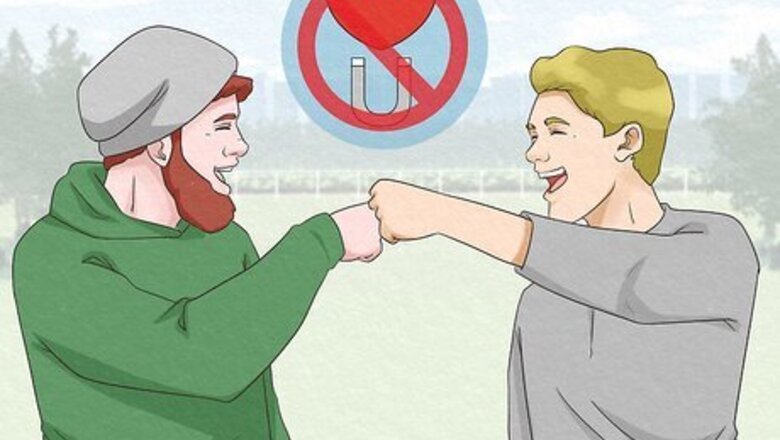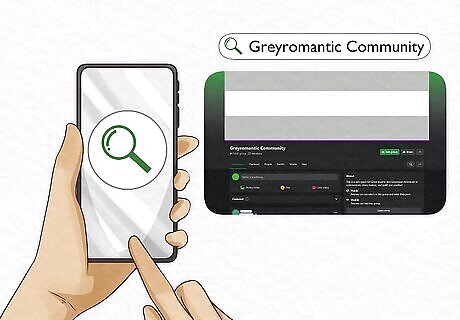
views
- Greyromantics rarely feel romantic attraction to other people or only feel romantically attracted to someone after forming an emotional bond with them.
- Greyromanticism is a romantic orientation and is distinct from sexual orientation. You can be greyromantic and have a totally different sexual orientation.
- You might be greyromantic if you don't relate to romantic stories or feel alienated by society's preoccupation with romance.
What does greyromantic mean?

Greyromantics feel little or no romantic attraction to others. Greyromanticism is part of the aromantic spectrum, which goes all the way from aromantic (no romantic attraction) to alloromantic (romantic attraction in line with the dominant culture). Greyromantics are somewhere in between and might experience romantic attraction sometimes, or under specific circumstances. Often this means they have to know someone really well or form an emotional bond with them before they can feel any romantic attraction, but the circumstances differ from person to person. People also combine grey with terms such as lesbian, bi, gay, straight, or queer to indicate who they would be interested in romantically. Being greyromantic or on the aromantic spectrum doesn't mean that you aren't capable of feeling love or empathy. Greyromantic people often have strong emotional connections with people—they just don't typically care for romance. It's also totally normal for people on the aromantic spectrum to be in a relationship. Just because someone rarely feels romantic attraction doesn't mean they never do!
Signs You Might Be Greyromantic

You don't relate to or enjoy romantic images or stories. As a greyromantic, that steamy romance novel your friend raves about just never made it into your "to be read" pile. You tend to stay away from romantic comedies and don't get butterflies thinking about big romantic gestures. You might think the whole idea of romance just seems cheesy or unrealistic or exaggerated. You might have had people dismiss you as cynical or cold-hearted, but nothing could be further from the truth. As a greyromantic, you're perfectly capable of loving, feeling empathy, and forming strong emotional bonds with people. You just don't see what romance has to do with any of that.

You feel alienated by society's emphasis on romance. You feel as though you've been told, either directly or indirectly, that your life is not complete without romance—and you just don't agree. You might have felt that there was something wrong with you or that you would never fit in because of this. It takes a lot of courage to recognize that there's nothing wrong with you or missing from you just because you don't agree with the dominant culture. It's okay to feel differently than the dominant culture says you're supposed to.

You've never (or rarely) had a crush on anyone. You might find it confusing when friends talk about having a crush on a stranger or someone they barely know. You can't imagine having those feelings for anyone at all, let alone someone you don't know very well. You might also find the idea of flirting with someone confusing or have no idea how to respond when someone is flirting with you (if you even realize they're flirting with you).

You aren't interested in starting a romantic relationship. As a greyromantic, romantic relationships aren't your priority. You might believe that friendships are more important than romantic relationships. You're also likely to prefer being single to being partnered up. When you do get involved in romantic relationships, you might feel as though you're doing so out of a sense of duty or what's expected of you, rather than because you have romantic feelings for the person.

You don't understand what romantic feelings are. If you lean more on the aromantic side of the spectrum, you might not even understand the concept of romantic feelings, or how those feelings might differ from other types of love, such as platonic love. You might find it confusing to think of someone "that way," or not understand how to differentiate between romantic attraction and other types of attraction. If you lean more towards the demiromantic side, you might think of this in terms of not being able to have romantic feelings about someone until you've gotten to know them really well and have an emotional bond with them.

You only feel romantic attraction in specific circumstances. A lot of people who identify as greyromantic can list specific conditions that must be in place for them to feel romantically attracted to someone. Typically, this involves knowing the person pretty well or having an attachment to them. For example, you might only feel a romantic attraction to someone after you've been friends with them for a while. Or you might only feel romantic attraction after you've been sexually intimate.

You don't feel romantic attraction even when you feel sexual attraction. Romantic attraction and sexual attraction are two totally different things. Many greyromantic people do feel sexual attraction, but without feeling any sort of romantic attraction at all. Often, this lack of romantic attraction persists even if you have a long-term sexual relationship with a person.

You seldom feel romantic attraction at all. Greyromantics who lean more toward the aromantic side of the spectrum will rarely feel any romantic attraction toward another person. This doesn't mean you're incapable of loving someone—you just don't feel those lovey-dovey romantic feelings that alloromantic people might feel. While some greyromantics can outline specific situations in which they could start to feel a romantic attraction, you might have never felt a romantic attraction before—even if you think it's possible that you could at some point.

You don't get the hype surrounding romantic attraction. Society likes to hype up romantic relationships as though they are the best, or most important, type of relationship. If you're greyromantic, you probably don't understand why romance is necessarily better than anything else. For example, you might feel as though you have a closer emotional bond with your friends than other people do with their romantic partners. You might also see platonic bonds as more stable and reliable than romantic bonds.
Greyromanticism Vs. Greysexualism

Romantic and sexual attraction are two different spectrums. It's totally possible for a person to have one romantic orientation and a totally different sexual orientation. You could have sexual feelings for someone without having romantic feelings for them. It's also possible for you to have romantic feelings only for people of some genders and have sexual feelings for people of other genders. For example, you might be bisexual but heteroromantic, which would mean that you are sexually attracted to people of multiple genders but you're only romantically attracted to people of one gender. People are called "alloromantic" or "allosexual" if their romantic or sexual orientation is on par with the dominant culture in society. Like using the term "cisgender" to describe someone who isn't trans, these terms promote equality with people who have alternative orientations. The idea that your romantic and sexual orientation always have to match up is heteronormative. While alloromantic people tend to also be allosexual, there's a lot more variety between people on the aromantic and asexual spectrums. This means your romantic orientation and your sexual orientation might not be the same, and that's totally normal.
Celebrating Greyromanticism

Display a greyromantic flag. There are several alternate greyromantic flags that have been created, but the most commonly recognized one has 5 stripes. The top and bottom stripes are green, followed by two gray stripes directly above and below, with a white stripe in the middle. The greyromantic flag is modeled after the greysexual flag but swaps the purple of the greysexual flag with the green used in the aromantic flag. You can also celebrate your greyromantic idea with other items that display the flag colors, including stickers, key chains, blankets, T-shirts, and posters. Your local Pride festival is a great place to find greyromantic gear, frequently handmade by local LGBTQIA+ artists.

Learn more about greyromanticism and the aromantic spectrum. There are tons of resources online that can help you learn more about romantic attraction, the aromantic spectrum, and where you fit in. You might also read blogs written by greyromantic people and others on the aromantic spectrum. Reading greyromantic blogs can help validate your own feelings and experiences and help you recognize that there are other people who feel the same way you do and have had similar experiences. The more you learn about the aromantic spectrum, the more you'll find to celebrate about your identity and your unique experience in the world.

Join greyromantic or aromantic groups on social media. Greyromantic and aromantic spectrum folks have groups and hashtags on all the social media platforms. These communities give people on the aromantic spectrum a chance to come together and relate to one another as a community. These groups can also help you feel less alone, especially if you live in a less diverse area that doesn't have a lot of LGBTQIA+ resources. The Asexual Visibility & Education Network also has discussion forums where you can ask questions and talk to other people on the aromantic and asexual spectrums.

Attend greyromantic or aromantic events. While people on the aromantic and asexual spectrums are included under the LGBTQIA+ umbrella (that's what the "A" stands for), many aromantic and asexual groups have their own separate events as well. These events are designed to focus exclusively on the aromantic and asexual communities so that your voices don't get lost. Remember that even if you are heterosexual in orientation, you're still a part of the LGBTQIA+ community if you identify as greyromantic.

Come out to people you believe will validate and support you. It takes a lot of courage to be completely out. If that's not something you're ready for, that's perfectly okay! It's good to take your time and share your identity only when you feel comfortable doing so. A lot of people choose to come out softly at first to people who they feel confident will strongly support them. For example, if you have other friends whose identities fall under the LGBTQIA+ umbrella, you might choose to come out to them first.
Supporting Someone Who Is Greyromantic

Accept the person's identity even if you don't understand it. When someone comes out to you as greyromantic, recognize that this is a label that resonates for them. As someone who cares for them, your job is to believe what they're telling you about themselves and their lived experience, even if it doesn't make sense to you or you've never seen them that way before. It's great to open up a dialogue with the person if you want to understand greyromanticism better, but also recognize that it's not their responsibility to educate you. You'll come across as more supportive if you research on your own, and then come to them with any questions you might have.

Ask the person what greyromanticism means to them. Greyromanticism means something a little different for each person. While you don't want to ask questions that might seem too intrusive, it's fine to ask them how they define greyromanticism for themselves or why that label resonates with them. If you don't know anything about greyromanticism, do a little research on your own before you talk to the greyromantic you know. They'll likely be thrilled that you've been doing the work to educate yourself.

Read blogs written by greyromantic or aromantic people. One of the best ways to understand the greyromantic or aromantic perspective is to read things written by people who identify somewhere on the aromantic spectrum. Many aromantic folks have blogs on WordPress, Tumblr, and other blog-hosting platforms to talk about their identity and their feelings about romantic attraction and romantic orientation. You might also ask a greyromantic person you know to list some blogs or websites they would recommend. Tell them that you want to learn more about greyromanticism so you can support them better. Remember that everyone experiences romantic orientation and romantic attraction differently. If you have any questions, ask your greyromantic friends if they relate to something you've read.

Break assumptions about romantic attraction and relationships. Many people believe that romantic attraction and sexual attraction are tied together and that a healthy relationship must have both. But the reality is that people on the aromantic and asexual spectrums are perfectly capable of having healthy, fulfilling relationships. For example, you might stop using phrases such as "just friends" or "friend zone," which imply that romantic relationships are superior to platonic relationships. If a greyromantic friend calls you out on something you said, thank them for correcting you and try to learn from your mistake.

Advocate for people on the aromantic spectrum. Working on yourself is great, but calling out assumptions that insult or alienate people on the aromantic spectrum is even better. Advocating for aromantic people helps normalize the aromantic spectrum and makes it safe for everyone to feel comfortable and happy being themselves. For example, if you hear somebody talking about how two people are "just friends," you might say, "A platonic relationship has no less value than any other type of relationship." The Aromantic-spectrum Union for Recognition, Education, and Advocacy (AUREA) has free printables you can download to learn more about how to advocate for and be an ally to people on the aromantic spectrum.

















Comments
0 comment